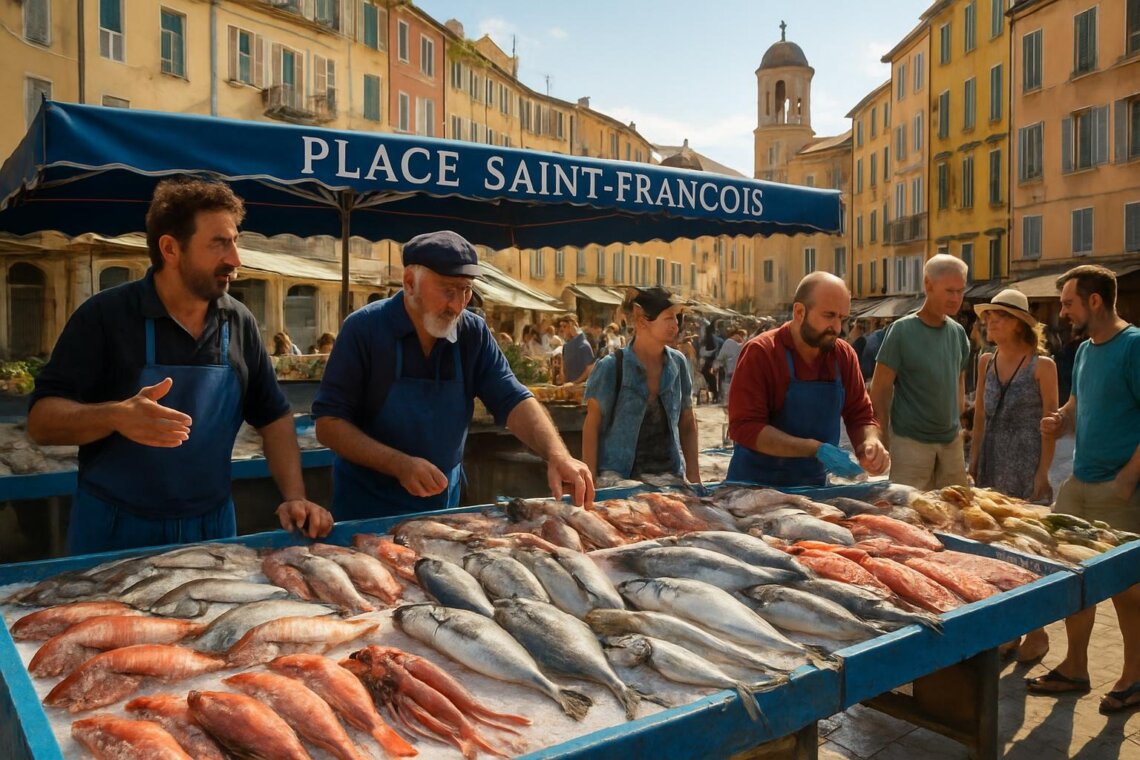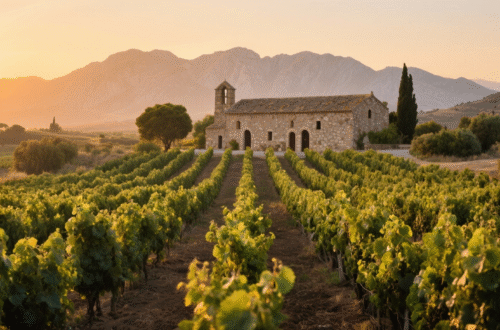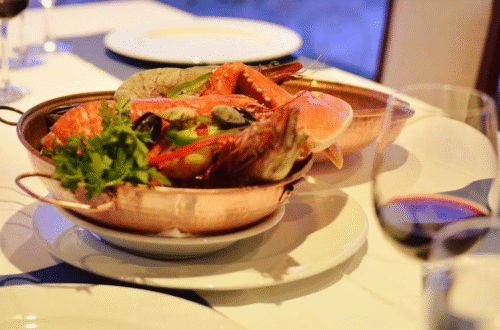
Exploring Nice Fish Market: Your Ultimate Guide to Fresh Seafood and Local Delights
Exploring Nice Fish Market: Your Ultimate Guide to Fresh Seafood and Local Delights
Imagine stepping into a world where the briny scent of the Mediterranean mingles with animated French conversations, where rainbow-colored displays of glistening fish catch your eye at every turn, and where centuries-old traditions come alive through the passionate calls of local fishmongers. Welcome to Nice Fish Market—a sensory feast that represents the beating heart of this stunning Côte d’Azur city’s culinary soul.
Whether you’re a dedicated foodie seeking the freshest Mediterranean catch, a curious traveler wanting to experience authentic Niçoise culture, or a home cook looking to elevate your seafood game, this comprehensive guide will transform your visit to Nice Fish Market from a simple shopping trip into an unforgettable cultural immersion. From understanding the market’s rich heritage to mastering the art of selecting the perfect sea bream, we’ll navigate every aspect of this maritime treasure together.
The Rich History of Nice Fish Market
The story of Nice Fish Market begins long before the glamorous reputation of the French Riviera took hold. Dating back several centuries, this vibrant marketplace has been the cornerstone of Nice’s fishing community, originally established when local fishermen would bring their daily catches directly from their boats to sell in what was then a simple outdoor space near the Old Port.
Located in the picturesque Place Saint-François in Nice’s Old Town (Vieux Nice), the market has witnessed the evolution of this Mediterranean coastal city from a modest fishing village to an internationally renowned destination. The cobblestone square itself tells stories of maritime heritage, where generations of fishing families have passed down their knowledge of the sea’s bounty from father to son, mother to daughter.
What makes this history particularly fascinating is how the market has maintained its authentic character despite Nice’s transformation into a tourist hotspot. The vendors you’ll encounter today often represent families whose ancestors sold fish in this very same spot generations ago. This continuity has preserved not just the market’s commercial function, but also invaluable traditional knowledge about Mediterranean fishing practices, seasonal availability, and preparation methods that have been refined over centuries.
The market’s cultural significance extends beyond mere commerce—it serves as a living museum of Niçoise culinary traditions. Here, you’ll discover that buying fish isn’t just a transaction; it’s a social ritual that reinforces community bonds and keeps ancient customs alive in our modern world. The market has survived wars, economic changes, and urban development precisely because it represents something irreplaceable: an authentic connection to the sea that has sustained Nice for millennia.

What Makes Nice Fish Market Unique
Step into Nice Fish Market and you’ll immediately understand why it stands apart from typical seafood vendors found elsewhere. The market’s uniqueness begins with its incredible variety of Mediterranean species—many of which you won’t find in other European markets. Daily catches include prized local fish like sea bream (daurade), sea bass (loup de mer), and the famous Niçoise anchovies that form the backbone of regional cuisine.
The vendors themselves are the market’s greatest asset. These aren’t merely salespeople; they’re custodians of maritime knowledge who can tell you exactly where each fish was caught, what fishing method was used, and how it should be prepared. Many of these fishmongers have been working the same stalls for decades, developing an almost supernatural ability to assess the quality of their seafood. Their expertise transforms shopping into an educational experience where you’ll learn about sustainable fishing practices, seasonal availability, and traditional cooking methods.
Sustainability plays an increasingly important role in what makes this market special. Many vendors work directly with local fishing cooperatives that practice responsible fishing methods, ensuring the Mediterranean’s delicate ecosystem remains healthy for future generations. You’ll find clear labeling indicating the origin of each fish, the fishing method used, and even recommendations for sustainable alternatives when certain species are out of season or overfished.
The market’s commitment to freshness is legendary among locals. Most vendors receive their stock directly from fishing boats that return each morning, meaning the fish you purchase may have been swimming in Mediterranean waters just hours earlier. This direct relationship between sea and stall eliminates the lengthy supply chains that can compromise quality, ensuring every purchase represents the pinnacle of freshness.
What truly sets Nice Fish Market apart, however, is its integration into daily Niçoise life. This isn’t a tourist attraction that happens to sell fish—it’s a working market where locals shop for their families, where relationships between vendors and customers span generations, and where the rhythms of the sea still dictate the rhythms of daily life.
Top Seafood Picks at Nice Fish Market
Navigating the abundant offerings at Nice Fish Market can feel overwhelming for first-time visitors, but knowing what to look for will enhance your experience immeasurably. The Mediterranean’s unique ecosystem produces fish with distinct flavors and textures that reflect the clean, mineral-rich waters of the French Riviera.
Essential Mediterranean Fish:
Sea bream (daurade) reigns as one of the most prized catches, known for its delicate, slightly sweet flesh that’s perfect for grilling or baking with herbs de Provence. Look for specimens with bright, clear eyes, firm flesh that springs back when pressed, and shiny, intact scales. The best sea bream will have a subtle ocean scent—never “fishy” or strong.
Sea bass (loup de mer) represents another market favorite, prized by local chefs for its versatility and refined flavor. These silver-skinned beauties should display the same freshness indicators as sea bream, with the added characteristic of firm, white flesh visible through the belly cavity.
Niçoise anchovies deserve special mention as they form the foundation of countless local dishes. Unlike their canned counterparts, fresh anchovies are mild, meaty, and incredibly flavorful. They’re essential for authentic pissaladière and add depth to salads and pasta dishes. Fresh anchovies should be silvery-blue with clear eyes and no signs of browning.
Premium Shellfish and Crustaceans:
The market’s shellfish selection rivals the best in France. Mediterranean mussels (moules) are typically smaller than Atlantic varieties but pack intense flavor. Choose specimens that are tightly closed or close immediately when tapped. Local oysters, while less famous than those from Normandy or Brittany, offer a distinctly mineral taste that reflects Mediterranean waters.
Prawns and langoustines from local waters command premium prices but deliver exceptional sweetness and texture. Look for translucent shells with no black spots, and avoid any with a strong ammonia scent.
Specialty Items Worth Seeking:
Monkfish (lotte) represents one of the Mediterranean’s most prized catches, with firm, lobster-like texture that holds up beautifully to robust preparations. The market’s monkfish is typically sold as tails, and you should look for pearly white flesh with no brown discoloration.
Local squid (calamars) are smaller than Atlantic varieties but offer superior tenderness and flavor. Fresh squid should have clear, bright eyes, firm bodies, and skin that changes color when touched.
Expert Selection Tips:
Trust your senses when selecting seafood. Fresh fish should smell like clean ocean water, never “fishy.” Eyes should be clear and bright, not cloudy or sunken. Gills should be bright red, and flesh should feel firm and spring back when pressed. For shellfish, listen for the sound of the sea when you hold shells to your ear—this indicates they’re still alive and fresh.

Insider Tips for Visiting Nice Fish Market
Timing your visit to Nice Fish Market can make the difference between a good experience and an unforgettable one. The market operates Tuesday through Sunday, with Monday being the traditional rest day for fishermen—a practice that has continued for centuries. The market operates from 6:00 AM to 1:00 PM, but the golden hours for serious shoppers are between 7:00 AM and 9:00 AM when the selection is at its peak and vendors are most energetic.
Optimal Timing Strategies:
Early morning visits offer the best selection, as popular items like sea bass and langoustines sell out quickly. However, if you’re not an early riser, visiting around 11:30 AM can yield excellent deals as vendors prefer to sell remaining stock rather than carry it over to the next day. Weekend mornings tend to be busiest with both locals and tourists, so weekday visits offer a more relaxed experience with more personalized attention from vendors.
Navigating the Market Layout:
Place Saint-François serves as the market’s home, and understanding its layout helps maximize your time. The square is relatively compact, with fish stalls arranged around the perimeter and a few in the center. The most established vendors typically occupy the prime spots along the sides, while newer or seasonal vendors may be found in center positions.
Start your visit by walking the entire market perimeter to see all available options before making purchases. This reconnaissance helps you compare prices, quality, and selection while building rapport with different vendors. The market’s intimate size means you can easily revisit stalls that caught your interest.
Pricing and Negotiation Insights:
Prices at Nice Fish Market reflect both quality and location—expect to pay premium prices for premium products. However, the quality justifies the cost, and you’re paying for freshness that’s simply unavailable elsewhere. Most prices are clearly marked, and while gentle negotiation is acceptable for large purchases, aggressive haggling is considered poor etiquette.
Building relationships with vendors can lead to better prices over time, special reserves of premium fish, and valuable cooking advice. Regular customers often receive preferred treatment, so if you’re staying in Nice for an extended period, consider developing loyalty to one or two vendors.
Cultural Etiquette and Communication:
French market culture emphasizes politeness and relationship-building. Always greet vendors with “Bonjour” and take time for brief pleasantries. Many vendors speak some English, but attempting basic French phrases is greatly appreciated and often rewarded with extra attention and advice.
Don’t handle fish or shellfish unless invited to do so. Instead, point to items that interest you and let vendors make selections. This shows respect for their expertise and maintains hygiene standards. When requesting specific preparations (filleting, cleaning), be clear about your needs and timeline.
Practical Considerations:
Bring a sturdy shopping bag or invest in a traditional French market basket—plastic bags are discouraged for environmental reasons. Consider bringing a small cooler with ice packs if you’re staying far from the market or planning to make multiple stops before returning home.
Payment is typically cash-only at most stalls, so come prepared with euros. Some larger vendors may accept cards, but don’t rely on it. ATMs are available nearby in the Old Town if needed.
Local Dishes and Culinary Experiences
Nice Fish Market serves as more than a shopping destination—it’s a gateway to understanding the sophisticated seafood cuisine that defines this Mediterranean paradise. The market’s offerings directly connect to dishes that have graced Niçoise tables for generations, creating an edible map of local culinary heritage.
Street Food and Ready-to-Eat Options:
The market area buzzes with immediate culinary gratification. Socca, a chickpea flour pancake found in markets and small cafés across the city, represents a true taste of Nice. While not seafood itself, socca becomes extraordinary when topped with fresh anchovies from the market, creating a perfect fusion of local specialties.
Vendors often offer prepared items like marinated anchovies, ready-to-eat shellfish, and traditional fish spreads perfect for picnicking along the nearby Promenade des Anglais. These prepared foods let you taste local specialties without needing cooking facilities, making them ideal for travelers staying in hotels.
Signature Niçoise Seafood Dishes:
Bouillabaisse, the traditional Provençal fish stew originating from Marseille, represents one of the region’s most celebrated dishes. While technically from nearby Marseille, Nice’s version incorporates local rockfish and Mediterranean herbs, creating a distinctly Niçoise interpretation of this classic.
The famous salade niçoise gains authenticity when made with anchovies purchased directly from the market. This iconic dish reflects Mediterranean freshness and serves as the showpiece of Nice’s food scene, highlighting the region’s sun-kissed produce. Traditional versions always include local anchovies, not tuna, making the market connection essential for authenticity.
Pissaladière, often called “Nice’s answer to pizza,” showcases the market’s anchovies in their full glory. This beloved local specialty features a thin, doughy base topped with caramelized onions, anchovies, and black olives. The quality of anchovies directly determines the dish’s success, making market-fresh specimens crucial.
Nearby Restaurants Serving Market-Fresh Seafood:
The area surrounding the fish market teems with restaurants that source directly from the stalls you’ve just visited. These establishments offer the opportunity to taste professional preparations of the same fish you’ve been admiring, providing inspiration for your own cooking adventures.
La Merenda has gained a following among locals for its intimate setting and fresh seafood offerings. This charming eatery exemplifies the market-to-table philosophy that defines Nice’s best seafood restaurants.
Many restaurants display their daily catches outside, sourced that very morning from the fish market. This transparency allows diners to see exactly what they’re getting and creates a direct connection between the market experience and restaurant dining.
Recipes Inspired by the Market:
The market’s offerings inspire countless home preparations that showcase Mediterranean flavors. Simple grilled sea bass with herbs de Provence allows the fish’s natural flavors to shine, while more complex preparations like fish soup (soupe de poissons) utilize smaller fish and trimmings often available at excellent prices.
Fresh anchovies can be prepared in numerous ways: marinated in lemon and olive oil, grilled quickly over high heat, or incorporated into pasta dishes with tomatoes and olives. The market’s vendors are excellent sources of preparation advice, often sharing family recipes passed down through generations.

Shopping Beyond Seafood
While fish remains the star attraction, Nice Fish Market exists within a broader ecosystem of local specialties that complement your seafood purchases perfectly. The market’s location in the heart of Old Town Nice means you’re surrounded by vendors offering everything needed to create complete Mediterranean meals.
Complementary Market Offerings:
Adjacent to the fish stalls, you’ll discover vendors selling locally grown herbs that pair beautifully with seafood. Fresh thyme, rosemary, and basil from Provençal gardens possess an intensity rarely found in supermarket versions. These herbs, when combined with market-fresh fish, create dishes that truly capture the essence of Mediterranean cuisine.
Local olive vendors offer varieties you won’t find elsewhere, including the famous Niçoise olives that appear in countless regional dishes. These small, dark olives possess a complex flavor profile that complements fish preparations perfectly. Many vendors also sell olive oils produced from local groves, providing the final component for authentic Mediterranean cooking.
Artisanal Cheeses and Local Wines:
The market area features cheese vendors specializing in regional varieties that pair excellently with seafood-based meals. Look for fresh goat cheeses from nearby Alpine villages, or aged varieties that add depth to fish gratins and stuffings. These local cheeses offer flavors unique to the Provençal terroir.
Wine vendors in the vicinity focus on local appellations, particularly rosé wines from Provence that complement seafood beautifully. These crisp, mineral-driven wines reflect the same Mediterranean character found in the market’s fish, creating perfect harmony when paired together.
Souvenir and Craft Opportunities:
The market’s surroundings offer numerous opportunities to purchase meaningful souvenirs that extend your Nice Fish Market experience long after your visit. Look for traditional Provençal ceramics designed specifically for serving seafood, including specialized plates for oysters and shallow bowls for bouillabaisse.
Local artisans sell handwoven baskets perfect for market shopping, allowing you to take home a piece of French market culture. These practical souvenirs serve as lasting reminders of your market experience while maintaining their functional purpose.
Creating Complete Mediterranean Meals:
Shopping beyond seafood allows you to create complete meal experiences that showcase the interconnected nature of Mediterranean cuisine. A typical market haul might include fresh fish, local vegetables, herbs, olives, cheese, and wine—everything needed for an authentic Niçoise feast.
Consider purchasing items for a traditional pan bagnat, Nice’s signature sandwich that combines market-fresh vegetables with anchovies or tuna. All ingredients are available within walking distance of the fish market, making it easy to assemble this local favorite for a seaside picnic.
The market’s proximity to bakeries selling traditional breads means you can purchase crusty loaves perfect for soaking up bouillabaisse or serving alongside grilled fish. These artisanal breads, still warm from morning baking, add an essential element to any Mediterranean meal.
Practical Information for Visitors
Successfully navigating your visit to Nice Fish Market requires understanding practical details that can make or break your experience. From transportation options to market etiquette, proper preparation ensures you’ll focus on the culinary adventure rather than logistical challenges.
Location and Transportation:
Nice Fish Market is located in Place Saint-François in the Old Town, making it easily accessible from most tourist areas in Nice. The market’s central location means it’s within walking distance of major hotels along the Promenade des Anglais, though the cobblestone streets of Old Town require comfortable walking shoes.
Public transportation connects efficiently to the market area. The nearest tram station is Place Garibaldi, just a five-minute walk from the market. From Nice Côte d’Azur Airport, take bus line 99 to Place Garibaldi, then walk to the market. This route avoids traffic congestion and provides a scenic introduction to Nice’s historic neighborhoods.
Driving to the market is possible but challenging due to limited parking in Old Town. If you must drive, arrive very early when parking spaces are available, or use one of the paid parking garages near Place Masséna and walk to the market. The walk provides an excellent opportunity to explore Nice’s charming historic streets.
Operating Schedule and Seasonal Variations:
The market operates Tuesday through Sunday from 6:00 AM to 1:00 PM, closing on Mondays. This schedule remains consistent year-round, though vendor participation may vary seasonally. Summer months see the largest selection and most vendors, while winter operations may be more limited but still maintain high quality.
Weather can affect market operations, particularly during mistral winds or heavy rain. On such days, some vendors may close early or not open at all. Check local weather forecasts and consider flexible timing during uncertain conditions.
Holiday schedules follow French traditions, with closures on major holidays like Christmas Day and New Year’s Day. During summer festival periods, the market may operate extended hours or special schedules, so check current information before planning your visit.
Accessibility and Family Considerations:
The market’s cobblestone setting presents challenges for wheelchair accessibility and those with mobility limitations. While the square itself is relatively flat, navigating between stalls and accessing individual vendors may prove difficult for some visitors. The historic nature of Place Saint-François means modern accessibility features are limited.
Families with children will find the market fascinating but should prepare for crowded conditions, especially on weekend mornings. Children are welcome, but parents should maintain close supervision due to wet floors, sharp objects, and busy vendor activity. The market’s sensory richness—sights, sounds, and smells—often captivates young visitors.
Stroller navigation through the market is possible but challenging due to crowds and uneven surfaces. Consider using baby carriers instead for easier movement and better interaction with vendors.
Safety and Hygiene Standards:
Nice Fish Market maintains high hygiene standards consistent with French health regulations. All vendors must comply with strict temperature controls, and you’ll notice extensive use of ice and refrigeration to maintain product quality. However, as with any fresh food market, use common sense regarding food safety.
Purchase seafood toward the end of your market visit to minimize time at ambient temperature. If you’re staying nearby, return to your accommodation quickly to refrigerate purchases. For longer trips, bring a cooler with ice packs to maintain cold chain integrity.
The market’s wet surfaces can be slippery, particularly early in the morning when vendors are setting up and washing down stalls. Wear appropriate footwear with good traction, and watch for wet spots while navigating between vendors.

Conclusion
Nice Fish Market stands as far more than a simple seafood shopping destination—it represents a living, breathing connection to centuries of Mediterranean maritime tradition. From the moment you enter Place Saint-François and inhale that distinctive blend of sea air and bustling market energy, you’re participating in a cultural experience that has remained essentially unchanged for generations.
Your journey through this guide has revealed the market’s multiple layers: its rich history rooted in local fishing traditions, the unparalleled quality and variety of Mediterranean seafood, the invaluable expertise of vendors who serve as custodians of culinary knowledge, and the direct connection between market purchases and authentic Niçoise cuisine. These elements combine to create an experience that transcends mere shopping to become cultural immersion.
The practical insights shared here—from optimal timing strategies to selection techniques to cultural etiquette—will transform you from a casual observer into an informed participant in this daily ritual of Niçoise life. Armed with knowledge about peak freshness hours, pricing dynamics, and vendor relationships, you’ll navigate the market with confidence while respecting its traditions and customs.
Perhaps most importantly, Nice Fish Market offers something increasingly rare in our globalized world: authenticity. In an age of industrial food production and international supply chains, this market maintains direct connections between sea and table, between traditional knowledge and daily practice, between community relationships and quality cuisine. Every purchase supports local fishermen, preserves traditional fishing methods, and maintains economic ecosystems that have sustained coastal communities for centuries.
The culinary possibilities that await you extend far beyond the market itself. Whether you’re planning to recreate classic bouillabaisse in your accommodation’s kitchen, seeking ingredients for an authentic salade niçoise, or simply wanting to taste the Mediterranean’s finest offerings prepared by local chefs, your market experience serves as the foundation for deeper culinary exploration.
As you plan your visit to Nice, remember that the fish market offers much more than souvenirs or photo opportunities—it provides a genuine window into the soul of this remarkable city. The relationships you build with vendors, the knowledge you gain about Mediterranean seafood, and the memories you create while navigating this sensory wonderland will enrich your understanding of Nice long after your visit ends.
Take time to truly engage with this special place. Ask questions, seek recommendations, observe the social dynamics, and allow yourself to be swept up in the daily drama of market life. Your willingness to participate authentically will be rewarded with experiences and insights that no guidebook can fully capture.
Don’t just visit Nice Fish Market—experience it, embrace it, and let it transform your understanding of what it means to eat seasonally, locally, and authentically in one of the world’s most beautiful coastal settings.
Ready to dive into Nice’s incredible seafood scene? Start planning your market adventure today by checking the current weather forecast, brushing up on basic French greetings, and preparing your senses for one of Europe’s most authentic culinary experiences. Your taste buds—and your understanding of Mediterranean culture—will thank you.
For the most current market information, operating hours, and special events, visit the official Nice tourism website. Share your own Nice Fish Market experiences and discoveries in the comments below—fellow seafood lovers are always eager to learn about hidden gems and vendor recommendations!




